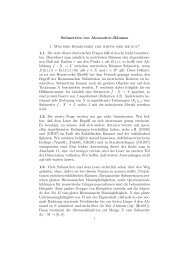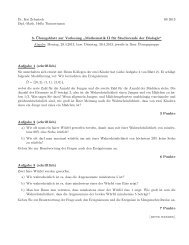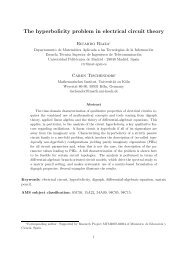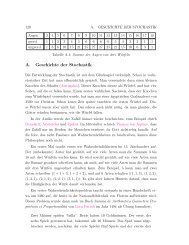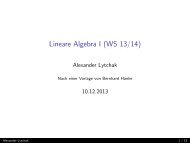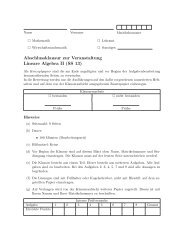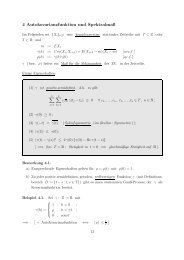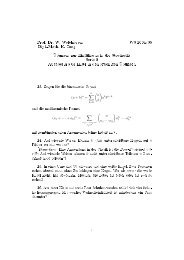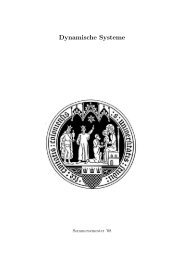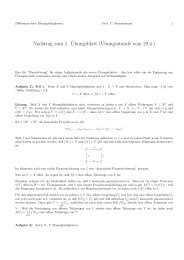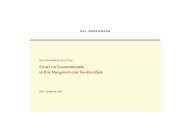Inhaltsverzeichnis - Mathematisches Institut der Universität zu Köln
Inhaltsverzeichnis - Mathematisches Institut der Universität zu Köln
Inhaltsverzeichnis - Mathematisches Institut der Universität zu Köln
You also want an ePaper? Increase the reach of your titles
YUMPU automatically turns print PDFs into web optimized ePapers that Google loves.
DMV Tagung 2011 - <strong>Köln</strong>, 19. - 22. September<br />
Oleg Bogopolski<br />
<strong>Universität</strong> Düsseldorf<br />
Generalized presentations of infinite groups, in particular of Aut(Fω).<br />
A very common way to describe a group G is by specifying generators and relations for G, with other<br />
words, by finding a set Λ and a subset R of the free group F(Λ) such that G is isomorphic to the quotient<br />
of F(Λ) by the normal closure 〈〈R〉〉 of R. Unfortunately, for certain groups G, it is difficult to find such a<br />
presentation.<br />
For example, take an infinite set X and look at the symmetric group Σ(X) of all permutations of X. It<br />
is obvious that the set of transpositions does not generate Σ(X). However, it is easy to see that each<br />
element of Σ(X) is, in a certain sense, an infinite product of transpositions. In the present paper, we are<br />
going to develop the concept of a generalized presentation of a group G. In the case of Σ(X), generalized<br />
generators are just the transpositions, and generalized relations are exactly the relations familiar from the<br />
finite symmetric groups Σn.<br />
An important ingredient of a generalized presentation is the notion of a big free group BF(Λ). If Λ is<br />
countably infinite, the group BF(Λ) was first studied by Higman in 1952; it is isomorphic to the fundamental<br />
group of the Hawaiian earrings. Whereas subgroups of free groups are again free, subgroups of big free<br />
groups need not be big free groups. Therefore we have to introduce the concept of generalized free<br />
groups; these are certain subgroups of big free groups.<br />
A generalized presentation of a group G consists, then, of a generalized free group F and of a subset R<br />
of F such that G is isomorphic, not simply to F /〈〈R〉〉, but to the quotient of F by the closure of 〈〈R〉〉 with<br />
respect to an appropriate topology on the group F .<br />
We give generalized presentations of the symmetric group Σ(X) and of the automorphism group of the<br />
free group of infinite countable rank, Aut(Fω). This is a joint work with Wilhelm Singhof.<br />
Kai-Uwe Bux<br />
<strong>Universität</strong> Bielefeld<br />
Subgroup conjugacy separability of surface groups<br />
Let G be a group. We call two elements g and h conjugacy separated if there is a finite quotient Q of<br />
G where g and h have non-conjugate images. We say that G is conjugacy separable if any two nonconjugate<br />
elements are conjugacy separated. Taking h = 1, we see that conjugacy separability implies<br />
residual finiteness.<br />
Similarly, we call subgroups H and H ′ of G conjugacy separated if there is a finite quotient Q of G where<br />
H and H ′ have non-conjugate images; and we say that G is subgroup conjugacy separable (SCS) if any<br />
two non-conjugate finitely generated subgroups are conjugacy separated. This property can be viewed<br />
as the subgroup-analogue of conjugacy separability very much in the same spirit as LERF is a subgroupanalogue<br />
of residual finiteness.<br />
Bogopolski and Grunewald have shown that free groups of finite rank are SCS. We show that fundamental<br />
groups of closed orientable surfaces are SCS. We conjecture that limit groups are SCS (they have been<br />
shown to be LERF).<br />
In the talk, I shall outline the proof for fundamental groups of genus at least 2. In particular, I want to<br />
stress how the hyperbolic metric that such a surface admits enters the picture. This is a joint work with<br />
Oleg Bogopolski.<br />
162




